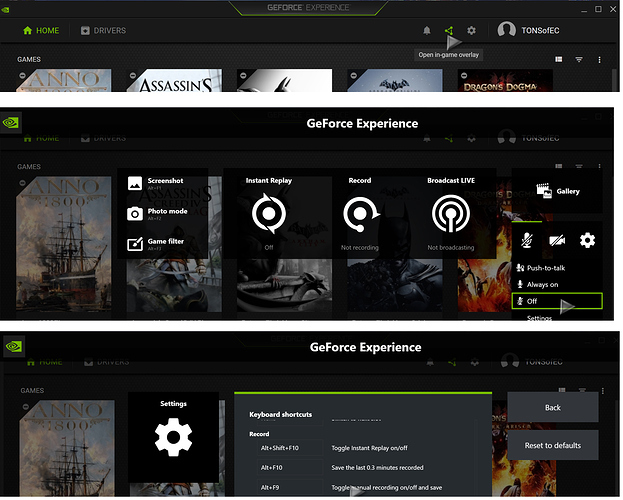I have a video I’m trying to edit. I’ve read all through the comments and videos about how to separate audio tracks from video tracks. I’m very new but I’m trying to follow all this. But I’m not sure any of this answers what I need. I was told that my voice was too quiet and was being drowned out in some parts by the game sounds. I want to be able to separate my voice and the game audio and lower the volume on one and raise it on the other as needed. Is this possible?
If you want to do it gradually then you would keyframe the Gain/Volume filter accordingly. The other option is to just split the clips where you want the volume levels to be different and use the Gain/Volume filter to set the level to where you want it to be for those parts.
I’m sorry. Like I said, I’m very new. Would you mind giving me a little more detail, please?
You should watch this tutorial on keyframes:
OK, I watched it and I think I kind of get it in theory. I’m obviously going to have to play with it. I’m still not sure I understand how this works when the game sounds and voices are happening at the same time since everything he did was one thing at a time, but maybe that will become more clear as I try it. Thanks for your help.
Is the recording of your voice on one audio track and the game sounds on a different separate audio track? I was responding to you with the assumption that they are on separate audio tracks because that way you can gradually raise the volume up and down between the voice and game soundtracks as you need them to be by keyframing each of those audio tracks separately.
That was my question I guess; how do I get them separated?
If the voice is coming from only one audio channel and the game sounds are coming from the other audio channel then there is a way. So if it’s a stereo track and your voice is coming from let’s say the left channel and the game sounds are coming from the right channel then you can go to a program like Audacity and split the left and right audio for each channel. Then they can be exported as two separate audio tracks to bring into Shotcut to work with them.
But if they are not separated like that then there isn’t much that you can do.
OK, thank you for being so patient with me. I’m going to go to bed for now and tackle it in the morning. Thanks!
My response will be in depth as to how to prepare your video file with game/mic audio channels and how to use them with Shotcut.
Click on the arrow below to see how I use OBS to prepare the source recorded video file with different audio tracks.
How I use OBS settings
I will be using OBS for this and creating a record-able audio environment so Shotcut can be used to separate. And this is how I use OBS, as I’m sure there are other more clever ways to use it, and the OBS has a very active forum on getting help for getting things set up.
I will not go over how to install OBS or how to get your game to be captured in OBS as there is a lot of videos and tutorials already out there on how to do this, which there is countless ways to configure OBS. The following are screenshots on how I use OBS settings to get the files I want.
Typically I only have two audio sources. Game goes to Desktop Audio (along with Discord), and Microphone to the Mic/Aux channel source.

Here I’m telling OBS that I want 3 audio tracks in my file.
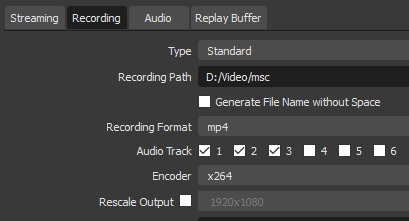
Track 1: Game/Mic mix Track2: Mic Track 3: Game
How the Audio Mixer looks on OBS (OBS has audio filters for each source that you can apply)

Once you’re done recording, you’ll have a file with 3 audio tracks to be used in Shotcut. It would be best to do multiple test recordings to find what levels work best for your. Depending upon the mic, you may have a gain control you can raise on the mic itself. This will eliminate the need to use Shotcut to edit your mic audio.
Once you get the video file with various audio tracks, this is how Shotcut sees them in the Properties/Audio tab. If your source video has game and mic on just two tracks you will only see two tracks here.
If you only see one audio track, the mic and game audio is mixed together and probably not editable.
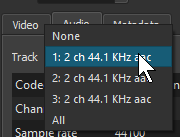
Shotcut only sees 1 audio track at a time. (not to be confused with audio channels as with left/right stereo channels.)
V1 could be your Game Audio track (as I had set to Track 3 via my OBS settings)
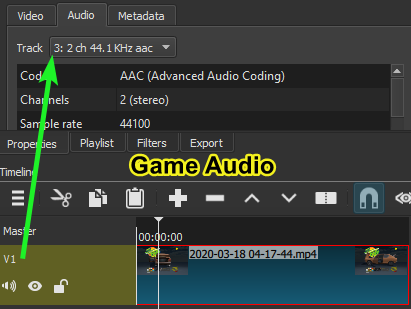
V2 could be your Mic Audio track (as I set to Track 2 via my OBS settings.
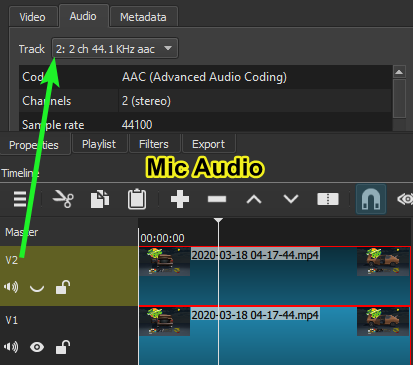
As @DRM explained, you can edit each audio track this way in Shotcut.
If you are using something other than OBS to record with, I do not know how to help you.
Hello Morgaine,
If I understand you correctly, you’ve recorded yourself talking and it is likely that you’re using the same thing to record the game as you’re using to record your voice.
If the above is true, then in my opinion, it would be better to have the game (and its sound) recorded using one method (like FRAPS or GeForce’s Experience) and be recording your voice using another way (like audacity). This way, the tracks are automatically separate from the start.
To do this, you will need headphones so you can hear the game without the sound of the game from the speakers going into the mic.
Now at that point you could just bring both things into Shotcut (create an audio track for your voice and a video track for your video and line them up accordingly (sidenote: if you use this method, say something that will make it easier to line the tracks up that you will split from the track and remove like “start” or “recording”)) and use filters to adjust the volume*(s)* on whichever track, but in my opinion you should do a search on how to improve the audio quality of your voice track and do those steps before bringing your voice track into Shotcut.
I’m pretty new to all this stuff myself but I hope this helps you out in some way. Give it time. You will make mistakes, get frustrated, etc, but that’s all fine. Stick with this, read, research, trial and error… and soon a lot of this stuff will go from you needing to look back and forth for each and every step… to you being able to do it while half asleep, lol.
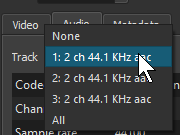
Where is this menu? I have looked at my settings in OBS and, by your description, I believe I have recorded my voice and game separately (completely by a happy accident if I did). But I can’t find this menu to move forward.
Thank you!
What settings do I need in OBS in order to record the game with GeForce and voice with audacity?
Unfortunately I’m not familiar with OBS. If you have a Nvidia graphics card, it comes with Shadowplay and you can just use that to record game play. You may have to set it to disable your microphone so it doesn’t record from your mic but it may be disabled by default.
To do this, you need GeForce Experience (which is free to download you just need to create an account) and this will allow you to set a hotkey for starting and stopping recording. You can also tell it to not record your desktop and record the game only.
To record your voice with Audacity, just open Audacity, make sure the mic is set to your mic and press “record”. You do this before entering the game you intend to record and simply say your word when you start recording the game so that you can align the tracks easier. Once aligned, you’ll cut that word out and all the silence before it in Shotcut.
If you must use OBS to record, I’m sure there’s a setting in there to not record from the mic and you can let audacity handle this on its own while OBS just records the game. If you’re having trouble finding (and or understanding them) your settings for OBS, I suggest doing a search on YouTube.
Keep in mind, there’s more than one way to do this stuff and everyone has their own preference*(s)* so try/look up different methods to find which one you prefer… but recording your mic using audacity makes it to where you don’t need to separate it later on and allows you to use other features of audacity to improve the sound quality.
Can I stream this way?
I know nothing about livestreaming. Wish I could help you out there but it shouldn’t be difficult to find tutorials on live streaming your plays whether you choose to do that through Youtube, Twitch, both or something else.
In Shotcut, click on the Source tab, or on the clip, then Properties, then Audio, and you’ll see an arrow to click on to see the other audio tracks.
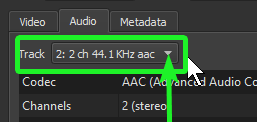
Personally I had way too many issues with GeForce Experience. There is no way for set/force GF Exp to record with a constant frame rate. OBS is standard in recording/streaming games on YouTube and Twitch. SLOBS (Streamlabs OBS) runs off of OBS’s platform specifically designed for streaming on Twitch.
OK, I think I determined that on that video there is only one track with all the audio on it, so I guess I’m out of luck on it. But do I have this set up on OBS correctly to have them separate on future videos?
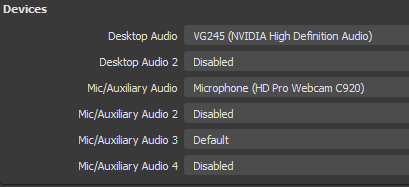
This will give you two audio sources, but if you look at my first response it shows how I set up OBS to use both sources.
Pretty much the C920 probably doesn’t have a decent mic on it. It may take a lot of testing on your part to get the right level before you record/stream. I had purchased a really crappy mic when I first started recording/streaming and would constantly edit the sound somewhat like @TONS had suggested with raising the levels with Audacity (I applied other filters), but did that 4 or 5 times before I just got a better mic and stopped editing the audio.
As far as I understand, you want to Adjust Volume separately for Gaming and Voiceover. The Solution here start by actually recording those two things separately. If you record normally using a headset, Raising One voice will raise the entire volume (Along with Game volume)
You can try the OSB Dual track trick as mentioned above or you could just simply use a second mic and cut the fuss. I just use a Mobile Phone with recording app placed in front of me. This way I Have complete control on Your Game and Voice Volume, apply separate effects, Normalize, Reduce noise and so on.

